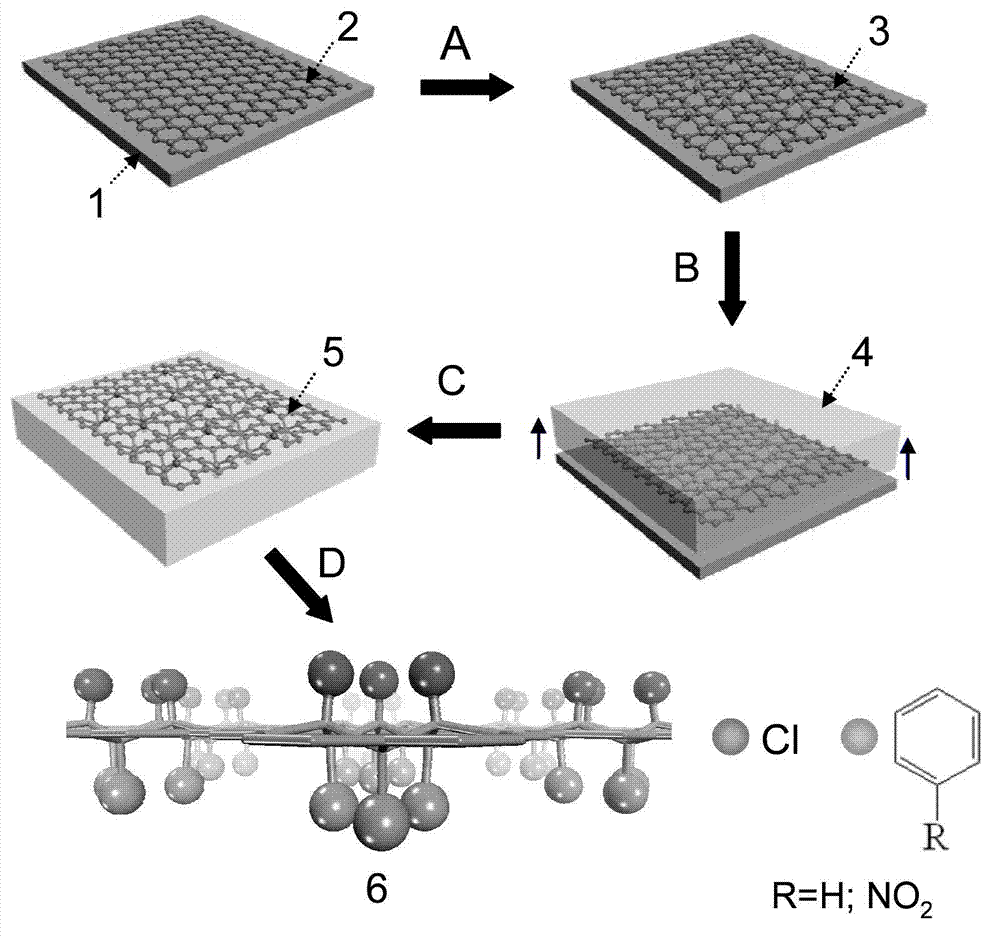Method for realizing double-surface asymmetric modification of single-layer graphene
A graphene, asymmetric technology, used in chemical instruments and methods, non-metallic elements, carbon compounds, etc.
- Summary
- Abstract
- Description
- Claims
- Application Information
AI Technical Summary
Problems solved by technology
Method used
Image
Examples
Embodiment 1
[0035] Example 1. Carrying out double-sided asymmetric covalent modification to single-layer graphene
[0036] 1) On Si / SiO 2 Substrate (Si layer thickness is 600μm, SiO 2 The substrate layer is 300nm) and the surface adopts the mode of mechanical exfoliation to prepare single-layer graphene, wherein figure 2 (a) is the Raman spectrum of single-layer graphene on the substrate surface.
[0037] 2) The photochlorination reaction is carried out on the surface of single-layer graphene, and the single-sided chlorination modification of graphene is realized under the protection of the substrate. The specific implementation steps are:
[0038] Using dilute hydrochloric acid (9mol / L) and manganese dioxide powder (5g) to react at 60°C to produce chlorine gas, using nitrogen as a carrier gas to feed the newly produced chlorine gas into the photochemical reaction system of graphene, under the irradiation of ultraviolet light, chlorine gas The decomposition produces chlorine radicals...
Embodiment 2
[0044] Example 2, Carrying out double-sided asymmetric covalent modification to single-layer graphene
[0045] 1) Chemical vapor deposition growth is carried out on the surface of copper foil, so that single-layer graphene is precipitated on the copper surface, and the graphene is transferred to another Si / SiO 2 on the substrate. Wherein, the annealing temperature is 1000° C., the growth environment is a low pressure environment (500 mTorr), the carbon source is methane, and the growth atmosphere is methane 35 sccm / hydrogen 2 sccm.
[0046] 2)-3) steps are the same as in Example 1.
[0047] 4) Using the PMMA film as a protective substrate, carry out nitrophenylation modification on the other side of the chlorination-modified graphene to obtain double-sided asymmetric covalently modified single-layer graphene. The specific implementation steps are:
[0048] The sample is placed in a p-nitrobenzene diazonium salt solution with a concentration of 20mmol / L, the temperature is c...
PUM
| Property | Measurement | Unit |
|---|---|---|
| thickness | aaaaa | aaaaa |
Abstract
Description
Claims
Application Information
 Login to View More
Login to View More - R&D
- Intellectual Property
- Life Sciences
- Materials
- Tech Scout
- Unparalleled Data Quality
- Higher Quality Content
- 60% Fewer Hallucinations
Browse by: Latest US Patents, China's latest patents, Technical Efficacy Thesaurus, Application Domain, Technology Topic, Popular Technical Reports.
© 2025 PatSnap. All rights reserved.Legal|Privacy policy|Modern Slavery Act Transparency Statement|Sitemap|About US| Contact US: help@patsnap.com



